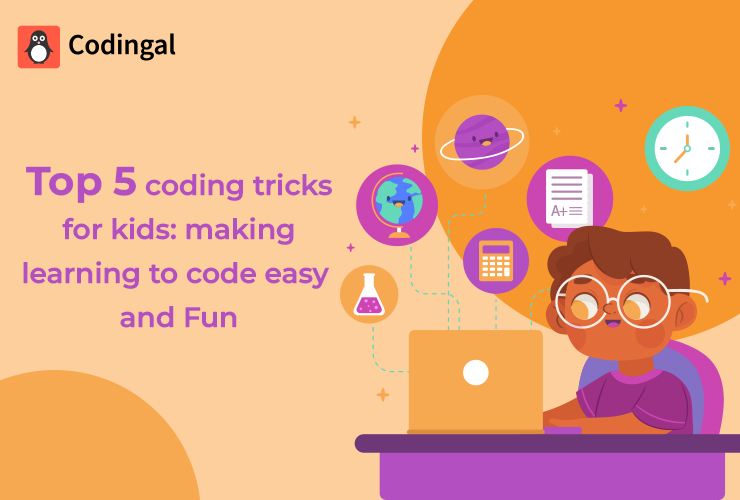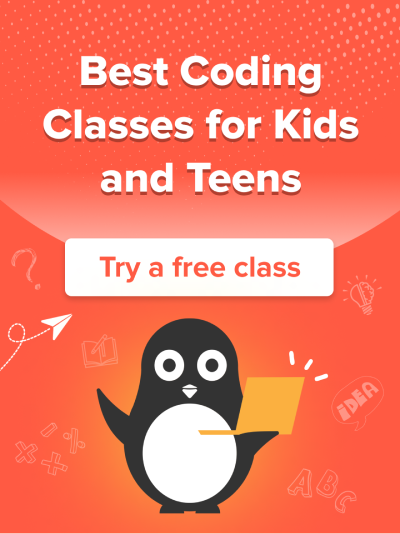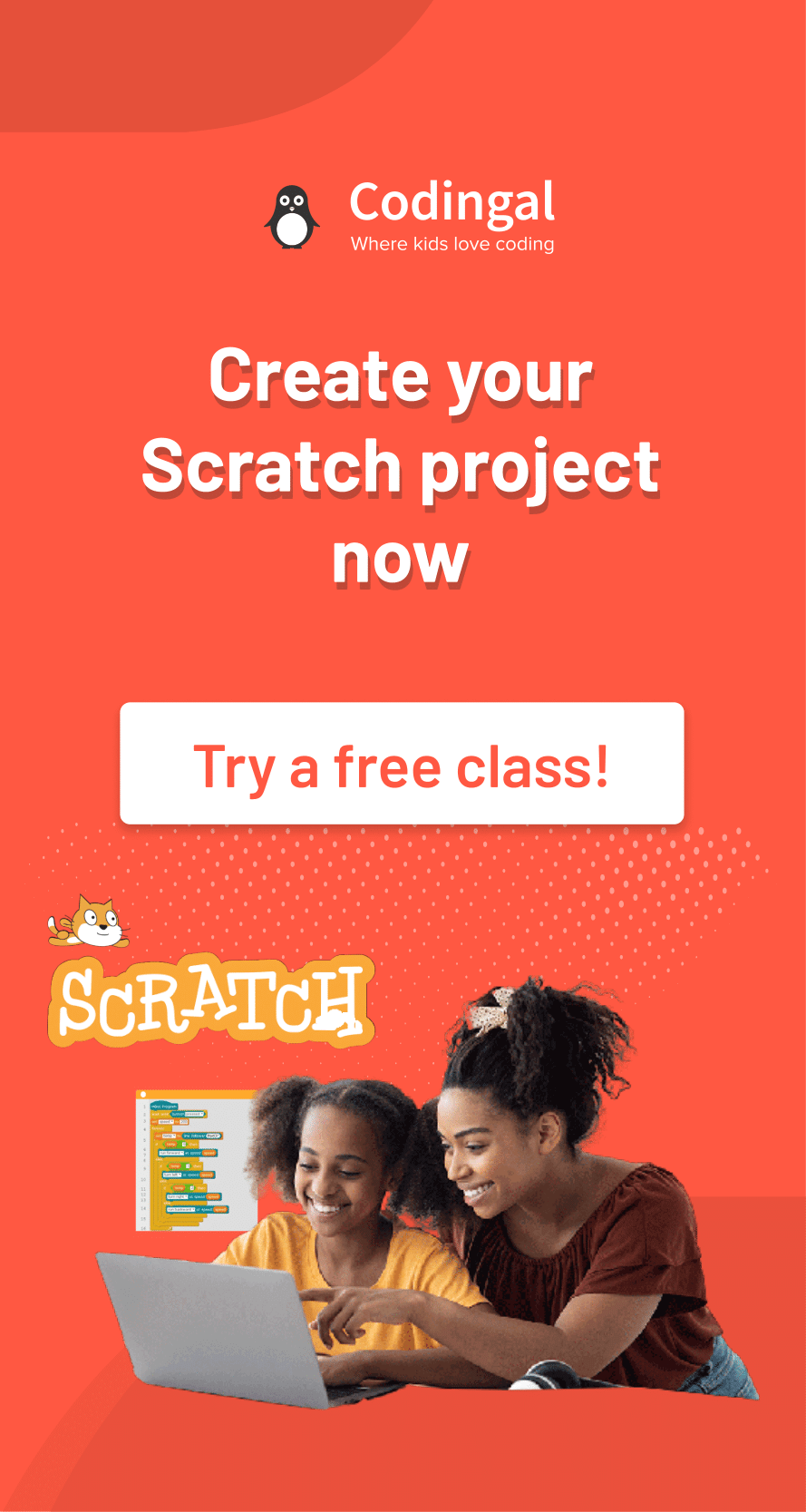Table of Contents:
Start with Scratch
Use Visual Aids
Gamify the Learning Process
Create Real-World Projects
Conclusion
In today’s digital world, coding has become an essential skill, and it’s never too early to start learning it. Introducing kids to coding at an early age ignites their creativity and helps them develop problem-solving and logical thinking skills. However, learning to code can sometimes seem intimidating, especially for young learners. That’s why we at Codingal have compiled a list of the top five coding tricks for kids to make learning to code easy and fun.
In this blog post, we will explore innovative and engaging techniques that will captivate young minds and turn coding into an exciting adventure. From interactive coding games to visual programming tools, these tricks will provide a solid foundation for kids to understand programming concepts while having a great time.
Whether your child is a beginner or has some coding experience, these tricks will help them grasp complex ideas effortlessly and foster a lifelong love to learn coding. So, let’s dive in and discover how to unlock the world of coding through these top five coding tricks for kids!
Start with Scratch
Scratch is a visual programming language and online community developed by the MIT Media Lab. It provides a user-friendly platform for children to learn coding fundamentals through interactive and creative projects. With its drag-and-drop interface, Scratch allows kids to create animations, games, and stories by snapping together code blocks.
Why Scratch Is an Excellent Starting Point for Kids to Learn Coding
Using Scratch as a learning tool has several benefits. It enhances critical thinking and logical reasoning abilities as kids learn to break down problems into smaller steps and sequence their solutions. Furthermore, Scratch builds a strong foundation for future programming languages by introducing core programming concepts such as loops, conditionals, and variables. Here are some pointers to explain why it is an excellent starting point for kids to learn to code:
- Simple to Understand
The intuitive nature of the platform makes it easy for young learners to grasp programming concepts without getting overwhelmed by complex syntax or debugging challenges. Children can see the cause-and-effect relationship by visually connecting code blocks, fostering a deeper understanding of programming logic.
- Encourages Creativity and Self-Expression
Kids can personalize their projects by designing characters, backgrounds, and sound effects. This flexibility promotes imaginative thinking and empowers children to bring their ideas to life, building confidence in their abilities.
- Promotes Collaboration and Community Engagement
The Scratch online community allows kids to share their projects, receive feedback, and remix others’ creations. This fosters a sense of belonging and provides opportunities for peer learning. Additionally, the community’s diverse projects inspire children to explore different programming concepts and techniques, expanding their knowledge and problem-solving skills.
Use Visual Aids
Visual aids are crucial in helping kids learn coding concepts, making understanding code more engaging and enjoyable.
Importance of visual aids in coding education
Here are some pointers highlighting the importance of visual aids in coding education:
- Enhanced Comprehension
Visual aids, such as diagrams, charts, and illustrations, can simplify complex coding concepts by presenting them visually. Kids can easily grasp abstract ideas when seeing visual representations of programming concepts.
- Step-by-Step Guidance
Visual aids visually represent coding processes, breaking them down into manageable steps. This visual sequencing helps kids understand the logical flow of programming and encourages them to follow a structured approach to problem-solving.
- Visual Representation of Data
Visual aids can help kids visualize and analyze data sets, making concepts like variables and loops more tangible. Graphs, charts, and animations help children interpret information, understand patterns, and make connections between data and programming concepts.
- Universal Language
Visual aids transcend language barriers and make coding accessible to a diverse range of learners. Regardless of their native language, kids can understand coding concepts through visual representations, fostering inclusivity in coding education.
How Visual Aids Can Make Learning to Code Fun for Kids
Visual aids, such as colorful diagrams, interactive animations, and engaging infographics, can revolutionize learning to code for kids. By providing a visually stimulating environment, these aids capture children’s attention, enhance comprehension, and make coding concepts more accessible and enjoyable, fostering a love for programming from an early age.
Gamify the Learning Process
Gamifying the coding learning process can revolutionize kids’ engagement with this valuable skill. Incorporating game elements and mechanics make learning to code more enjoyable, interactive, and accessible.
How Gamification Enhances the Learning Process of Coding
Here’s how gamification is one of the best coding tricks for kids that enhances the learning experience:
- Fun and engaging
Games have an inherent ability to captivate and motivate children. Gamification creates an enjoyable learning environment by transforming coding lessons into interactive challenges, quizzes, or puzzles. This boosts kids’ enthusiasm and encourages them to participate in their coding journey actively.
- Hands-on problem-solving
Games allow kids to solve coding problems within a structured context. This hands-on approach stimulates critical thinking and problem-solving skills. As children navigate coding quests, they learn to analyze challenges, break them down into smaller parts, and devise creative solutions.
- Immediate feedback and rewards
Games offer instant feedback, reinforcing positive learning behaviors. Kids receive real-time responses for their coding attempts, enabling them to make adjustments and learn from their mistakes. Gamification also introduces rewards, such as badges, points, or level-ups, which motivate children to progress and celebrate their achievements.
Create Real-World Projects
Creating real-world projects for kids to work on offers numerous benefits beyond theoretical learning and engaging them in practical applications. These projects allow kids to apply their coding skills in tangible ways, fostering creativity, problem-solving abilities, and a deeper understanding of programming concepts.
The most significant example of real-world projects for kids is creating a website or a simple app. They can learn HTML, CSS, and JavaScript while designing and structuring web pages by developing their website. Kids can equip the basics of app development by creating a small mobile application that solves a specific problem or provides a useful service. This project allows kids to see the immediate results of their coding efforts and offers a sense of accomplishment when their website is up and running.
Engaging in these real-world projects bridges the gap between theoretical knowledge and practical implementation, showing them how coding can solve real problems and create valuable products.
Conclusion
Learning to code has never been more crucial in today’s technology-driven world, as it opens doors to endless opportunities and empowers individuals to shape the future. Codingal urges parents and educators to embrace the power of fun and engaging techniques to teach coding to children. By incorporating tricks and interactive activities, we can ignite a passion for coding in young minds and equip them with vital skills for the digital age. Join our coding courses to learn coding in a fun and engaging way!












